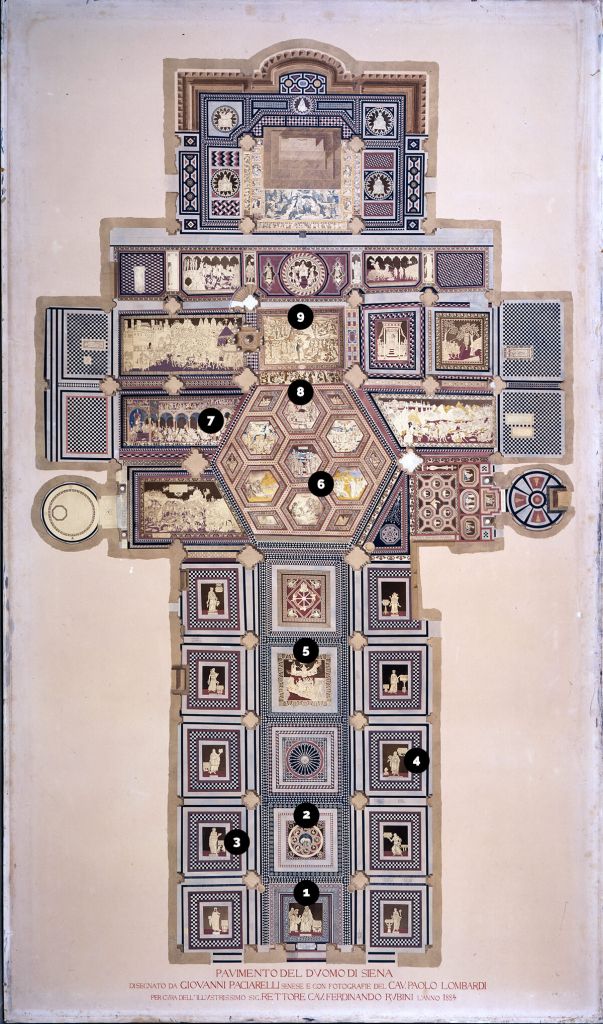is how Giorgio Vasari described the floor of Siena Cathedral, the product of a programme implemented between the 14th and the 19th centuries.
Siena Cathedral contains numerous masterpieces from every age, but its marble mosaic inlay and graffito floor is in many ways its most prized possession. Giorgio Vasari certainly considered it the “most beautiful…, largest and most magnificent floor ever made”. The floor we see today is the product of a programme implemented between the 14th and the 19th centuries. The preparatory cartoons for the fifty-six inlay panels were supplied by leading artists, all of them Sienese save for the Umbrian painter Bernardino di Betto known as Pinturicchio, who designed the inlay depicting the Mount of Wisdom in 1505. The technique used to transpose the various artists’ ideas onto the floor is known as graffito and mosaic marble inlay. Simple to begin with, the technique gradually achieved an astonishing degree of perfection. The first inlays were traced out on white marble slabs using a chisel and a drill and then filled in with black stucco, a technique called “graffito”. This was supplemented by a technique based on placing coloured marble pieces together using the marquetry method, a technique known as marble mosaic inlay.
The marble mosaic inlay floor is unique both in terms of the technique used to make it and in terms of the message enshrined in its figured panels: a constant invitation to embrace Wisdom.
Nave
An inscription invites the visitor, on entering the nave, to adopt a fitting attitude for someone about to enter a sacred temple: CASTISSIMUM VIRGINIS TEMPLUM CASTE MEMENTO INGREDI (Remember to enter chastely into the most chaste temple of the Virgin).
The first marble inlay to greet the visitor (made by Giovanni di Stefano in 1488) depicts Hermes Trismegistus, the founder of human wisdom; together with the Sibyls (1482–3) in the side aisles, Hermes is part of an iconographical pathway based on 4th century Christian writer Lactantius’ Divinae Institutiones.
In accordance with the writings of Varro there are ten Sibyls(five per side aisle) named after their respective geographical areas: the Persian Sibyl, the HellespontineSibylla, the ErythraeanSibylla, the PhrygianSibylla, the Samian Sibyl and the DelphicSibyl for the Greek and eastern world; the Libyan Sibylla for Africa; and the Cumaeanor CimmerianSibyl, the Cumana(Virgilian) Sibyl and the TiburtineSibyl for the Western world, and thus Italy.
Moving down the nave past the panel of Hermes, we encounter the She-Wolf Suckling the Twins, set in a circle surrounded by eight smaller roundels containing the emblems of central Italian cities.
Transept and chancel
While the nave and side aisles contain episodes from Classical antiquity and the pagan world, the transept and chancel relate the story of the Children of Israel and the story of salvation accomplished and achieved in the figure of Christ, who is constantly evoked but never actually portrayed in the floor since He is present on the altar towards which the entire artistic and spiritual journey converges. The subject matter is all taken from the Old Testament except forMatteo di Giovanni’s Slaughter of the Innocents. The horrific scene, which is being played out under the observer’s very eyes, is based on the story in the Gospel of St. Matthew.
The hexagon beneath the dome (Stories from the Life of Elijah and Acab) and other panels close to the altar (Moses Striking Water from the Rock; Moses on Mount Sinai; The Sacrifice of Isaac) are by Mannerist painter Domenico Beccafumi, who so perfected the marble mosaic inlay technique that he managed to achieve a chiaroscuro effect with it.
GROUND PLAN OF THE FLOOR
Position of the masterpieces:
1 Herms Trismegistus – Giovanni di Stefano
2 The wolf suckling Romulus and Remus – Leopoldo Maccari
3 The Cumaean Sibyl – Giovanni di Stefano
4 The Hellespontine Sibyl – Neroccio di Bartolomeo
5 Allegory of the Mount of Wisdom – Pinturicchio
Uncovering The Floor
Valid for 2025:
27 June – 31 July; 18 August – 15 October
From Monday to Saturday:
- Cathedral, Baptistery, Crypt 10:00 am – 7:00 pm
- Museo dell’Opera 9:30 am – 7:30 pm
- Oratory of San Bernardino 1:30 pm – 6:30 pm
Sunday (only during uncovering the floor):
- Cathedral 9:30 am – 6:00 pm
- Baptistery, Crypt 10:00 am – 7:00 pm
- Museo dell’Opera 9:30 am -7:30 pm
- Oratory of San Bernardino 1:30 pm – 6:30 pm
No further admission after half an hour before Museum closing time.
Opening times may vary in the event of religious services.
PRICES
From 27 June to 31 July and from 18 August to 15 October 2025
FULL PRICE
€ 8,00
REDUCED TICKET (Groups and school groups > 14 and groups with a guide)
€ 6,00
FREE
- Children up to 6 years of age
- Siena municipality residents and born
- Journalists
- Disabled visitors (+ one carer per visitor)
- Clerics of both genders
- Students of University of Siena and University for Foreigners of Siena
- Parish groups of the Archdiocese of Siena with a letter from the parish priest
CALL CENTER
Information, reservations and ticket sales.
+39 0577 286300
TICKETS
Immediate access to the masterpieces of the Monumental Complex of the Duomo, reducing waiting times
A SINGLE TICKET THAT ALLOWS ACCESS TO THE CATHEDRAL ROOFS AND TO ALL THE MUSEUMS OF THE COMPLEX
FULL PRICE
01/03 – 06/01: € 21,00
REDUCED TICKET (CHILDREN FROM 7 TO 11 YEARS OF AGE)
01/03 – 06/01: € 6,00
FREE (CHILDREN UP TO 6 YEARS OF AGE)
Remember to always consult the rules of conduct before accessing the tour.
A SINGLE TICKET THAT ALLOWS ACCESS TO ALL THE MUSEUMS OF THE COMPLEX.
Valid for three consecutive days from the date of issue.
FULL PRICE
01/01 – 26/06; 01/08 – 17/08; 16/10 – 31/12: € 14,00
during floor uncovering
(27/06 – 31/07; 18/08 – 15/10): € 16,00
REDUCED TICKET (CHILDREN FROM 7 TO 11 YEARS OF AGE)
01/01 – 31/12: € 3,00
FREE
- Children up to 6 years of age
- Siena municipality residents and born
- Journalists
- Disabled visitors (+ one carer per visitor)
- Clerics of both genders
- Students of University of Siena and University for Foreigners of Siena
- Parish groups of the Archdiocese of Siena with a letter from the parish priest
THE CULT
The Duomo is by definition the house that welcomes the Christian community gathered for liturgical celebrations. Therefore the Cathedral is always accessible to the faithful for prayer through the Door of Forgiveness.
HOLY MASS TIMES
Weekdays: 9:30 am (Chapel of Our Lady of the Vow)
Holidays and days before holidays: 8:00 / 11:00 / 12:15 / 18:00 (Summer 18:30)
In the periods when the floor is uncovered, Holy Masses are celebrated in the church of the Santissima Annunziata:
Weekday: 9:30 am Holidays: 8:00 am – 6:30 pm
For times on the occasion of solemnities or special events see the news section.
* Those born and resident in the Municipality of Siena have free access to the entire monumental complex of the Duomo





